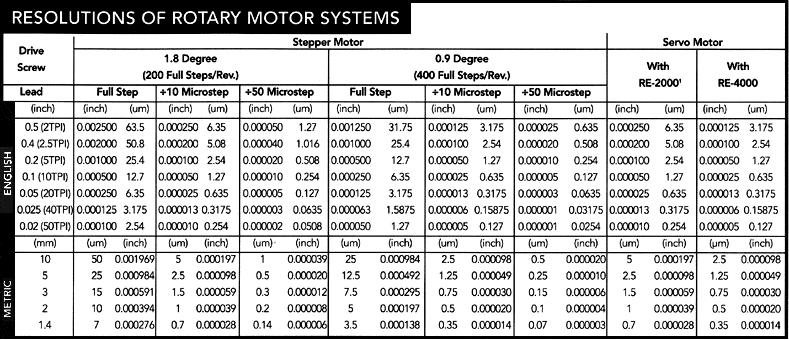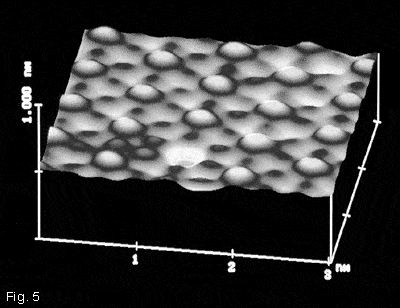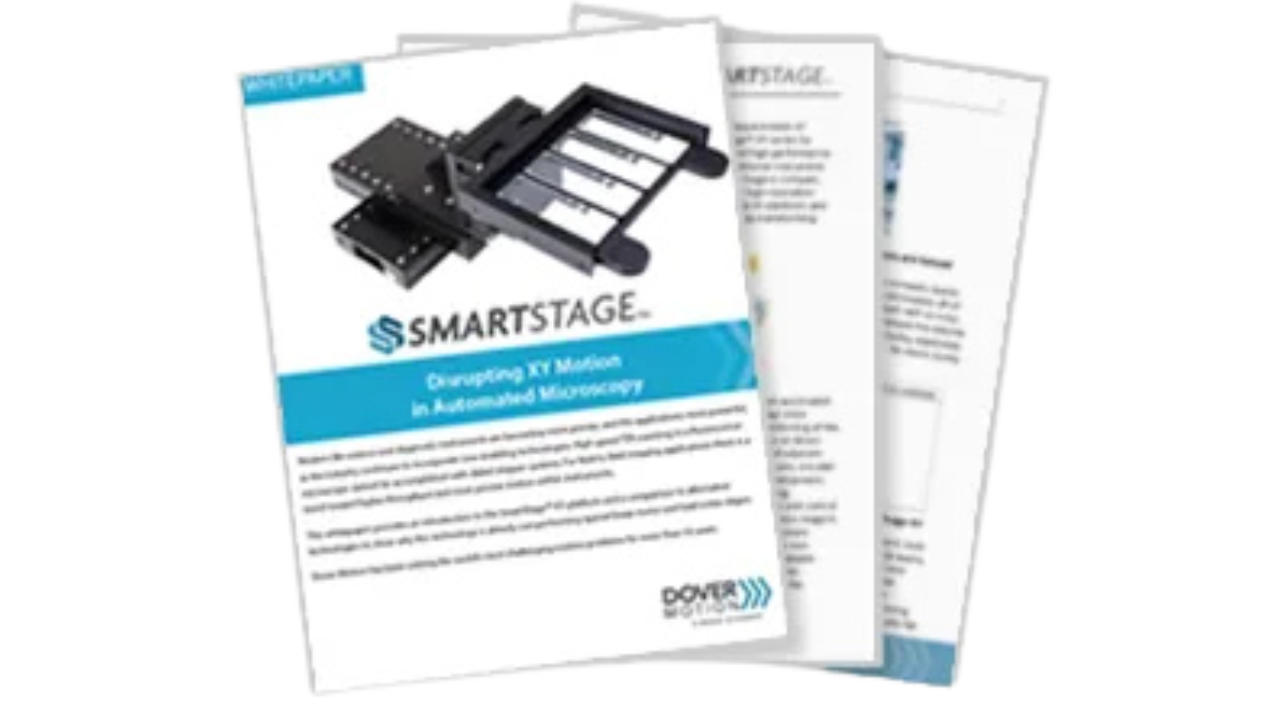Resolution
Resolution is defined as the smallest positional increment which can be commanded of a motion control system.
Aspects that play a role in determining the overall system resolution include:
- Mechanical positioning components
- Motor
- Feedback device
- Electronic controller
Stepper Motor Lead Screw: Using Microstepping to Increase Resolution
A stepper motor system’s resolution is set by the stepper motor lead screw pitch, motor step angle, and drive electronics. For any given pitch, two full-step resolutions can be achieved through the use of either 1.8-degree or 0.9-degree stepping motors which provide 200 and 400 full steps/revolutions, respectively. Full-step resolution can be further increased by microstepping. Dover microsteppers electronically subdivide each full step into 10 or 50 microsteps to produce 2,000 or 10,000 microsteps per revolution with 1.8-degree steppers, or 4,000 or 20,000 microsteps per revolution with 0.9-degree motors. While microstepping can be implemented with higher division ratios than 50, the increased resolution is often of limited use. This chart provides resolutions for our full line of stepper motor lead screws and ball screws, together with motor options and microstepping drives. You can read more about microstepping here

Defining Your Resolution
The key question to ask in determining the required system resolution is “What are the minimum incremental moves which must be performed in a given application?” Resolution is easily over-specified or confused with accuracy or repeatability. In general, it is appropriate to specify a resolution that is about 5 times smaller than the position error that is required by the application. Popular resolutions for stepper motor stages are 0.0001 inches and 1 micron. To achieve a resolution of .0001 inch, a 0.20-inch lead screw is used with a 200 step/revolution motor operated in ÷10 microstep mode. To achieve a resolution of 1 micron, a 2-millimeter lead screw is used with the same motor.
Resolution and Servo Systems
 The resolution of servo systems that utilize rotary encoders is a function of the lead screw pitch and the encoder resolution. Rotary encoders are characterized by the number of lines per revolution and Dover control electronics can perform 4 times that line count. For example, the Dover RE-2000 rotary encoder has 500 lines, which is translated to 2,000 counts per revolution in the counting electronics. The resulting linear resolution is shown in the accompanying chart above. Use of the Dover RE-2000 rotary encoder provides the same resolution for a given lead screw as that of our divide-by-10 microstepper. The resolution of servo systems incorporating linear encoders or laser interferometers is independent of the screw pitch and is strictly a function of the positional feedback device. In some cases, the lead screw is replaced with a linear motor which requires the use of a linear encoder. Standard Dover linear encoders provide resolutions of 5, 2, 1, 0.5, 0.25, or 0.1 micron, with interpolation electronics built into the encoder read head. Diffraction-based linear encoders are optionally available, providing resolutions as low as 20 nanometers. Finally, laser interferometers can be supplied as feedback devices, providing a single pass resolution of 10 nanometers and a double pass resolution of 5 nanometers.
The resolution of servo systems that utilize rotary encoders is a function of the lead screw pitch and the encoder resolution. Rotary encoders are characterized by the number of lines per revolution and Dover control electronics can perform 4 times that line count. For example, the Dover RE-2000 rotary encoder has 500 lines, which is translated to 2,000 counts per revolution in the counting electronics. The resulting linear resolution is shown in the accompanying chart above. Use of the Dover RE-2000 rotary encoder provides the same resolution for a given lead screw as that of our divide-by-10 microstepper. The resolution of servo systems incorporating linear encoders or laser interferometers is independent of the screw pitch and is strictly a function of the positional feedback device. In some cases, the lead screw is replaced with a linear motor which requires the use of a linear encoder. Standard Dover linear encoders provide resolutions of 5, 2, 1, 0.5, 0.25, or 0.1 micron, with interpolation electronics built into the encoder read head. Diffraction-based linear encoders are optionally available, providing resolutions as low as 20 nanometers. Finally, laser interferometers can be supplied as feedback devices, providing a single pass resolution of 10 nanometers and a double pass resolution of 5 nanometers.
The Trouble with High Resolutions
As finer and finer resolutions are sought, an important distinction arises between the smallest increment that can be commanded and the smallest increment that can be achieved. Unachievable, or “empty,” resolution allows dramatic product claims to be made but provides no useful benefit. For example, driving a 0.5-millimeter lead screw with a 50,000-step-per-revolution microstepper, or a 50,000-count/revolution rotary-encoded servo motor, produces a nominal 25-nanometer resolution. However, the friction present in the motor, nut, and ways (especially those of recirculating type), renders bi-directional moves of this magnitude impossible. Meaningful resolutions below the 100-nanometer level require a minimization of mechanical friction, typically through the use of air bearing ways and non-contact linear servo motor drives. An integrator is also required in the servo loop to avoid the excessive gains that would otherwise be necessary to achieve such small incremental moves. Another difficulty with very high resolutions is the resulting limit on top speed as the electronic counting circuitry sets a cap on the number of counts per second that can be processed. Perhaps the ultimate level of positioning resolution has been achieved in the Scanning Tunneling Microscope (STM), which was awarded a Nobel Prize in Physics in 1986. In this device, and the related Atomic Force Microscope, piezoelectric technology and elaborate vibration isolation measures are used to achieve better than 0.1-angstrom resolution—less than 0.00001 micron or 0.0000000004 inches—allowing detailed pictures of surface atomic structures to be viewed. Note the missing atom in Figure 5. This STM image shows a single-atom defect in iodine adsorbate lattice on platinum.

Figure 5: Iodine Atoms on a Platinum Substrate

